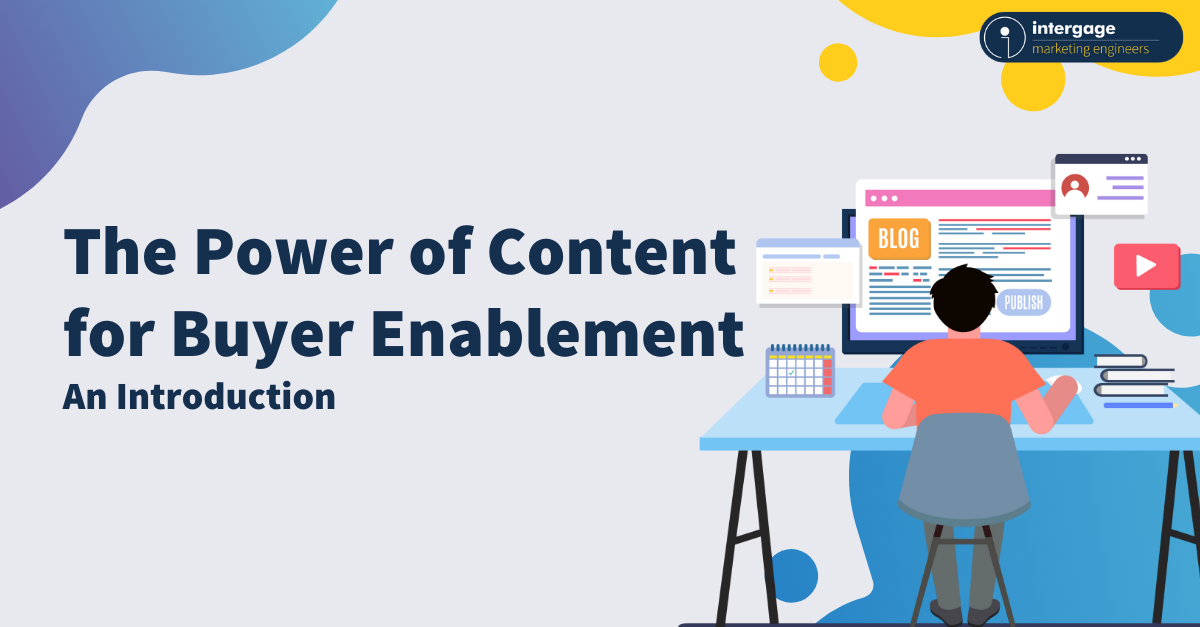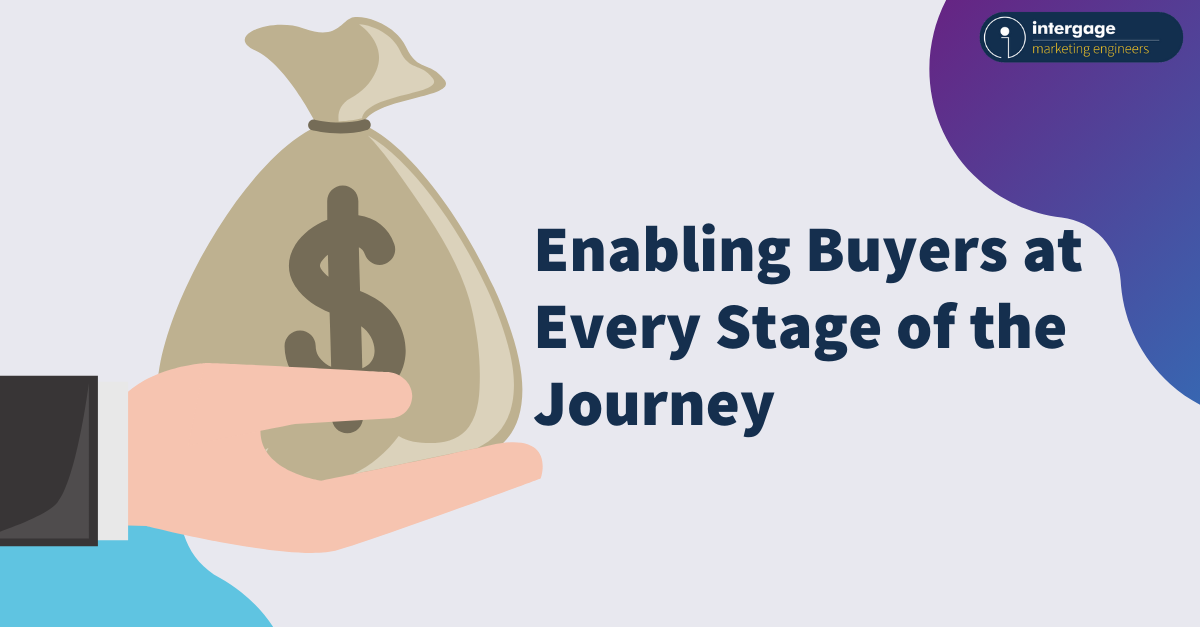Mapping buyer journey jobs and stages for buyer enablement
Every step in the B2B buying journey is a balancing act of roles and responsibilities. The buying journey unfolds across distinct stages — awareness, consideration, decision, and retention — with each having its own set of tasks and strategies to complete and implement.
To understand how best to approach the B2B buying journey, it is critical to first understand how the different buying jobs evolve across stages. Equally, it is necessary to consider the challenges specific to intermediary and end-users’ needs, so that as little surprises you as possible.
Navigating the B2B Buying Journey
The B2B buying journey unfolds into four key stages, each with its own distinctive traits:
Awareness
At this point, potential buyers have only just awakened to the realisation of a need or opportunity. It's the moment when problem or aspiration is illuminated for the first time, often by the end-users. In their recognition of the need for change, they identify the pain points and begin exploring possible solutions.
Consideration
The journey progresses as the buyers begin their search for the perfect solution for their problem or aspiration. Alongside them, a group of intermediaries emerge, ready to shoulder the responsibility of gathering options and insights. They become the guides, helping end-users navigate the labyrinth of choices. Together, they evaluate different paths, weighing the pros and cons of potential solutions.
Decision
Enter: the decision-makers. Ultimately, they hold the authority, making the final call on which path the team will take. The intermediaries and influencers remain close-at-hand, providing counsel and support to decision-makers as they finalise their choice and sign on the dotted line.
This culminates in the grand decision — the moment of commitment. Congratulations!
Retention
Except, the journey doesn’t conclude once contracts have been signed and everyone’s legal departments are happy. Arguably, the fourth phase of the buying journey is the longest, with a potential for it to go on indefinitely.
Welcome to the world of customer retention, where end-users continue to engage with the chosen solution as it’s implemented into their work. Intermediaries ensure the relationship between buyer and supplier remains harmonious, and decision-makers keep an eye on the key metrics of the journey’s progress, adjusting as needed to ensure alignment with the organisation's goals.
Understanding Buying Jobs
Now, let's dive deeper into how these roles evolve through each stage, defined by the jobs the buying committee needs to complete in order to commit to a sale and solve their problems. These don't necessarily occur in the linear layout below - for instance, a decision maker could have a provider in mind before a problem is discovered - but they all need to be completed before a deal can be closed.
Problem Identification
This is the moment of awareness, the "something must be done about this," where the penny (finally) drops. This job may seem simple, but it can be a major hurdle: the acceptance that something isn't working means the potential for blame, insecurity, and the beginning of 'blockers', who see any future deal as potentially harmful to their position.
Solution Identification
Once a problem has been recongnised and diagnosed, the buying committee can turn towards scouting out potential solutions. Research-heavy and an information avalanche, the committee needs to weigh up potential solutions for them, but also in general. Bear in mind: they still won't have spoken to a salesperson at this point - their research is typically self-led.
Requirements Building
"What exactly is it that our purchase needs to do?" is the crux of this buying job. The committee needs to draw up a list of features, abilities, and limitations for each potential solution to compare businesses' offerings against. As a result, this can rule solutions and companies out of the running before they're even aware someone is looking into their offerings.
Supplier Selection
Supplier selection marks the first point where the buying committee may reach out to potential suppliers for input. With their list of requirements, they can begin to piece together a solution tailored to their needs; how do suppliers and their offerings compare to their needs? Only then can they move from making decisions to consolidation and implementation of their desired solution.
Validation
Welcome FOMU: the fear of messing up. Getting validation for their decision is important for the team's future consensus creation; if they all agree on the best solution, and validate one another's decisions, they're one step closer to getting the purchase completed. The benefit of all their prior research is most prominent here: doing the job of buying properly means easier validation.
Consensus Creation
Decision-makers, by design, orchestrate the grand finale. The job of those involved in every other stage of the buying journey is to build wider consensus - whether this is taking their findings to their head of department or Board. Being able to present a complete and compelling case for their chosen solution will offer their higher-ups greater piece of mind.
It's only once a consensus has been reached by all those with a say and sway in the process that they can finally sign on the dotted line.
Content and Interactions for Each Role
Throughout the process, the content you provide and the interactions you have with members of the buying committe will need to be personalised to each buying job to be most effective:
End-Users
These are the people who'll be using or implementing the solution on a day-to-day or managerial basis. Here's how best to reach out to them through content:
- Engage them with educational content in the problem awareness stage, showcasing how your solution aligns with their needs.
- When it comes to the solution identification and supplier selection stages, provide them with detailed product information.
- After the decision, nurture their skills with training and support materials for effective retention; if they excel using the product, they’re more likely to meet the targets set by decision-makers.
Intermediaries
Neither the end-users or the decision makers, intermediaries are tasked with bridging the gap between these parties. Their loyalties lie in both places, and your content needs to reflect their needs. You can:
- Offer comprehensive comparison guides and expert consultations in the solution identification stage so they feel, and are, well-informed.
- As you move towards consensus creation, and later retention, provide them with ongoing support and resources to assist them in their role as liaisons between decision-makers and the end-user.
Decision-Makers
Holding the keys to the kingdom is a powerful role, but it comes with distinct responsibilities to both company and colleagues. Decision makers need all the facts, even those the rest of the committee haven't yet passed on:
- Present business case studies and ROI analyses in the requirements building stage, fulfilling their need for solid facts to inform their thinking.
- Offer personalized proposals, demonstrating how well your product/service fits their needs, for the supplier selection stage.
- Then in retention, deliver performance reports and insights so they can make informed decisions as to whether they’ll continue your business relationship.
Influencers
Influencers can sway other members of the committee with their opinions, so it's crucial to have them on-side. Here's a few ways to do so:
- Engage them initially with industry insights and thought leadership content in the supplier selection stage, so they are informed and aware of your business.
- Leverage their expertise for guiding decision-makers in the validation stage.
- Continue to maintain an ongoing dialogue with them beyond the sale, where appropriate.
Challenges Faced by Intermediaries and End-Users: Navigating the Rough Waters
Intermediaries
It’s the intermediaries who shoulder the complex task of managing multiple perspectives and needs, often becoming the bridge between end-users and decision-makers.
In this challenging role, they must ensure alignment with organizational goals while harmonizing the varied—and potentially at-odds—voices within the buying committee. Theirs is the task of filtering through a sea of solutions, negotiating terms, and safeguarding the organization's interests, and it can feel like navigating turbulent waters.
Providing intermediaries with the necessary tools and resources they need becomes paramount, as it will enable them to streamline their role in helping decisions get made. In doing so, businesses can fortify this critical link, ensuring smoother navigation through the intricate B2B buying journey.
End-Users
At the other end of the spectrum, end-users spend their time embarking on a journey of discovery, searching for solutions that will transform their daily operations for the better. Not unlike their intermediary counterparts, these quests have their own challenges.
First and foremost: the abundance of information and myriad options available can be overwhelming. As end-users seek clarity amid the complexity, businesses must step in to simplify the decision-making process.
The most straightforward way to do this includes providing value propositions, easily accessible product information, and continuous post-purchase support. These become pillars which can support end-users as they navigate their information-heavy tasks. By addressing these challenges with empathy and insight, organizations can empower end-users to make confident decisions, ensuring any journey from awareness to retention is as smooth as possible for both parties.
Where we stand
The B2B buying journey is in its own way an epic narrative, rich with characters and roles. By understanding the dynamics of each stage and the influence of buying jobs, businesses can create compelling content and interactions tailored to everyone. Breaking down the whole into multiple stages, each with their own key stakeholders, enables a more manageable approach for all involved—and, hopefully, better business for you.
Read more in our guide to navigating the B2B buying landscape here.




